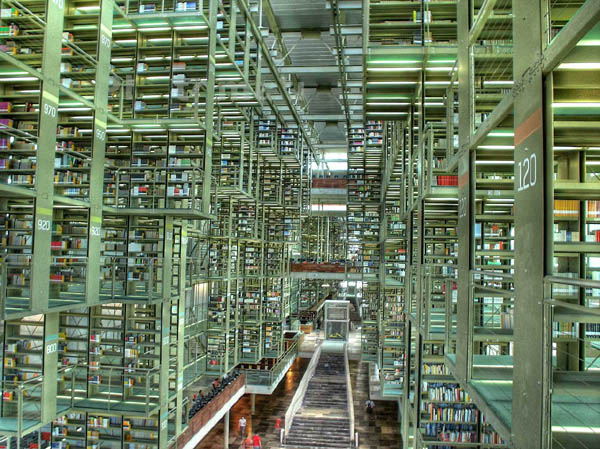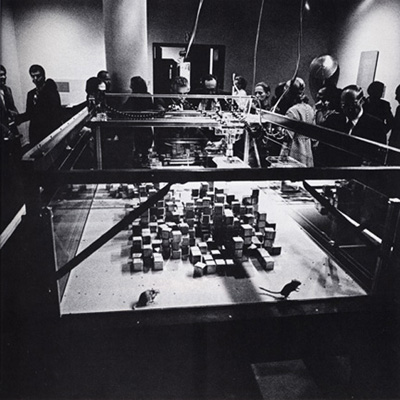I was beginning to research an article about ARG genres when I came across this interesting tidbit. Without telling the client, an architect renovating an Upper East Side apartment included secret panels, puzzles, poems and artworks that – when they discovered it – led its residents on a scavenger hunt around their own home.
A frequent topic at if:book is the fetishization of the codex in its irreducibly physical qualities. This project – complete with its own fictionalized Da Vinci Code-esque book hidden in the walls of the apartment – takes this to new heights, while arguably gesturing at some of the elitism (the costliness and exclusivity of the postbit atom) implicit in this fetishization.
Category Archives: architecture
the tomb of the book

“Vista de la Biblioteca Vasconcelos” by Eneas, on Flickr
A lovely meditation at BLDG Blog on the architecture of storage facilities for unwanted books. Speaks volumes (as it were) to the anxiety of obsolescence that keeps librarians up at night -? the thought of libraries themselves becoming tombs.
…a relatively random piece of 100-year old legislation – dealing with copyright law, of all things – has begun to exhibit architectural effects.
These architectural effects include the production of huge warehouses in the damp commuter belts of outer London. These aren’t libraries, of course; they’re stockpiles. Text bunkers.
…Perhaps it will take some future moment of cultural archaeology to break into these places, spelunking back into the literate past, to find well-tempered rooms still humming at 50ºF, humidity-free, where the past is refrigerated and Shakespeare’s name can still be recognized on the spines of books.
the good life: part 1
The Van Alen Institute has organized an exhibition that explores new design and use of public space for recreation. The exhibition displays innovative designs for reimagined and reclaimed public spaces from various architects and urban planners. The projects are organized into five categories: The Connected City, the Cultural City, the 24-Hour City, the Fun City, and the Healthy City. As part of the exhibition, the Van Alen Institute has been holding weekly panel discussions about designing public space from international and local (NYC) perspectives. The participants have been high level partners in some of the most widely regarded architecture firms in NYC and the world. The questions and discussions afterwards, however, have proved to be the most interesting part; there have been questions about autonomy and conformity in public space, and how much of the new public space has been designed for safety, but little else. They have become ‘non-spaces’, and fail to support public needs for engagement, relaxation, and health.
This week their discussion will move away from the architectural and planning and into new technology. It will be interesting to see how technology supports and influences ideas of connectedness in a public place; while the value of connecting to others from a private, isolated space seems obvious, doing so from a public place seems less common and less intuitive than face-to-face interaction. The panel, including Christina Ray (responsible for the Conflux Festival ) and Nick Fortugno (Come Out & Play Festival), will present and discuss “The Wired City” at 6:30 pm on Wednesday, Sep. 27.
discursions II: networked architecture, a networked book
I’m pleased to announce a new networked book project the Institute will begin working on this fall. “Discursions, II” will explore the history and influence of the Architecture Machine Group, the amazing research collective of the late 60s and 70s that later morphed into the MIT Media Lab. The book will be developed in collaboration with Kazys Varnelis, an architectural historian whom we met this past year at the Annenberg Center at USC, when he was a visiting fellow leading the “Networked Publics” research project.

As its name suggests, the Architecture Machine Group was originally formed to explore how computers might be used in the design of architecture. From there, it went on to make history, inventing many of the mechanisms and metaphors of human-machine interaction that we live, work and play with to this day. Lately, Kazys’ focus has been on contemporary architecture and urbanism in the context of network technologies, and how machine-mediated interactions are becoming a key feature of human environments. So he’s pretty uniquely positioned to weave together the diverse threads of this history. Most important from the Institute’s perspective, he’s interested in playing around with the form and feel of publication.
And good news. Kazys recently resettled here on the east coast, where he will be heading up the new Network Architecture Lab (NetLab) at Columbia’s Graduate School of Architecture, Planning, and Preservation. One of the lab’s first projects will be this joint venture with the Institute. Unlike Without Gods and GAM3R 7H30RY, both of which are print-network hybrids, “Discursions, II” will grow one hundred percent on the network, beginning from its initial seeds: a dozen videos of seminal ARCMac demos, originally published on a video disc called “Discursions”. The book will also go much further into collaborative methods of work, and into blurring the boundaries of genre and media form, employing elements of documentary film, textual narrative, and oral history (and other strategies yet to be determined).
From the NetLab press release (AUDC, mentioned below, is Kazys’ nonprofit architectural collective):
Formed in 2001, AUDC [Architecture Urbanism Design Collaborative] specializes in research as a form of practice. The AUDC Network Architecture Lab is an experimental unit at Columbia University that embraces the studio and the seminar as venues for architectural analysis and speculation, exploring new forms of research through architecture, text, new media design, film production and environment design.
Specifically, the Network Architecture Lab investigates the impact of computation and communications on architecture and urbanism. What opportunities do programming, telematics, and new media offer architecture? How does the network city affect the building? Who is the subject and what is the object in a world of networked things and spaces? How do transformations in communications reflect and affect the broader socioeconomic milieu? The NetLab seeks to both document this emergent condition and to produce new sites of practice and innovative working methods for architecture in the twenty-first century. Using new media technologies, the lab aims to develop new interfaces to both physical and virtual space. This unit is consciously understood as an interdisciplinary entity, establishing collaborative relationships with other centers both at Columbia and at other institutions.
The NetLab begins operations in September 2006 with “Discursions, II” an exploration of history of architecture, computation, and new media interfaces at the Architecture Machine Group at MIT done in collaboration with the Institute for the Future of the Book.
For a better idea of Kazys’ interests and voice, take a look at this fascinating and wide-ranging interview published recently on BLDGBLOG. Here, he talks a bit more about what we’re hoping to do with the book:
The goal, then, is to create a new form of media that we’re calling the Networked Book. It’s a multimedia book, if you will, that can evolve on the internet and grow over time. We’re now hoping to get the original players involved, and to get commentary in there. The project won’t be just the voice of one author but the voices of many, and it won’t be just one form of text but, rather, all sorts of media. We don’t really know where it will go, in fact, but that’s part of the project: to let the material take us; to examine the past, present, and future of the computer interface; and to do something that’s really bold. It’s not that we don’t know what we’re doing [laughter] – it’s that we have a wide variety of options.
Congratulatons, Kazys, on the founding of the NetLab. We can’t wait to move forward with this project.
making visible the invisible: george legrady installation at seattle central library
A nice companion piece to the “database of intentions” is George Legrady‘s new installation, “Making Visible the Invisible,” at the Rem Koolhaas-designed Seattle Central Library. Six large LED display panels suspended above the “mixing chamber” on the library’s fifth floor display a series of visualizations depicting the circulation of library books and other media across time and classification area, providing “a real-time living picture of what the community is thinking.”
KeyWord Map Attack

Legrady described the project at the Transliteracies conference this past June in Santa Barbara. At that time, Bob blogged:
the pinpoint accuracy of computer-searches, leaves those of us lucky enough to have spent time in library stacks, nostalgic for the unexpected discovery of something we didn’t know we were looking for but which just happened, serendipitously, to be on a nearby shelf. George Legrady, artist and prof at UC Santa Barbara, just showed a project he is working on for the new public library in Seattle that gave the first glimpse of serendipity in online library searching which lets you see all the books that have recently been checked out on a particular subject. Beautiful and Exciting.
Vital Statistics

Floating Titles

Dot Matrix Rain

Other observations:
“New piece for Central Library pushes art to the technical edge” in Seattle Post Intelligencer
Information Aesthetics profile
